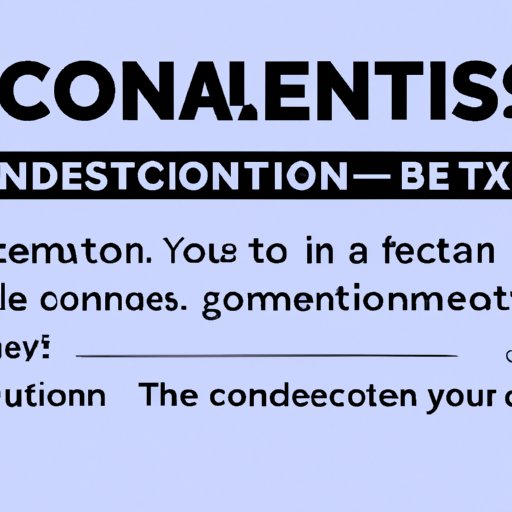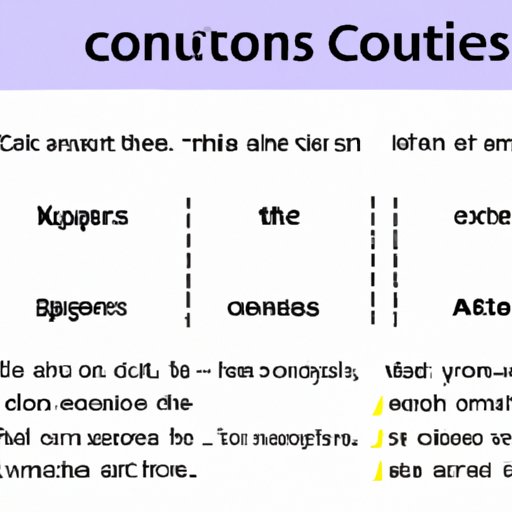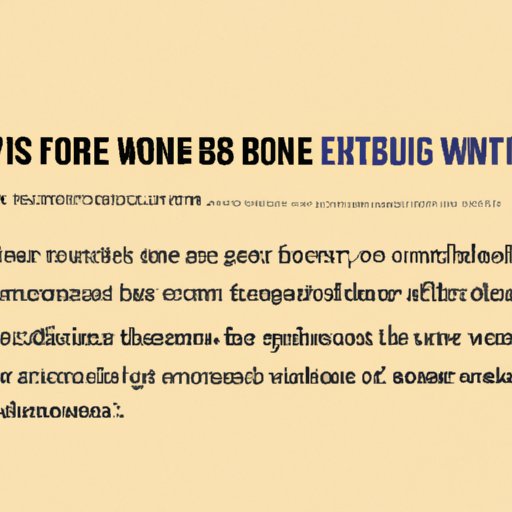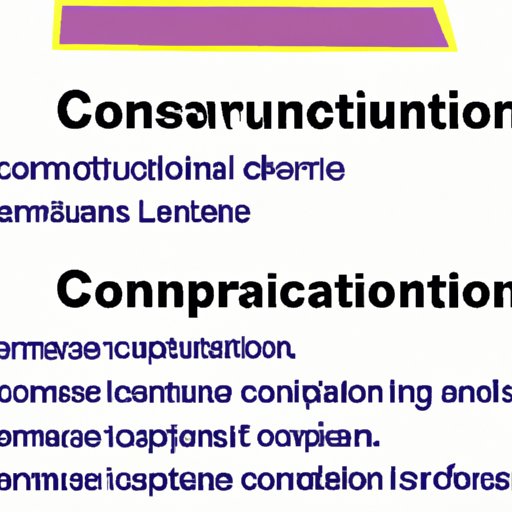Introduction
Contractions are words or phrases that have been shortened by combining two or more words into one shorter word. They are commonly used in informal language and can be a great way to add emphasis, create a conversational tone, and make your writing sound more natural. In this article, we will explore what contractions are, how they are used in writing, and why they should be used.
Exploring Contractions in Writing: What are They and Examples
Before diving into how to use contractions in writing, let’s start with the basics. A contraction is a combination of two words that are shortened by omitting one or more letters. Common examples of contractions include “don’t” (do not), “can’t” (cannot), and “won’t” (will not). Other examples of contractions include “I’m” (I am), “we’re” (we are), and “they’ve” (they have).
How to Use Contractions in Writing: A Comprehensive Guide
Now that we’ve established what contractions are, let’s dive into how to use them in writing. The general rule is that contractions should only be used in informal writing, such as emails, blog posts, and social media posts. They should not be used in formal writing, such as research papers and essays.
When it comes to using contractions in writing, there are some basic guidelines to follow. First, contractions should only be used when it makes sense to do so. For example, if you are writing a formal letter, it would be inappropriate to use contractions. Second, when using contractions, make sure to spell them correctly. Finally, when using contractions, pay attention to punctuation. For example, when using the contraction “it’s” (it is), you should always use an apostrophe before the “s”.
The Power of Contractions: Why You Should Use Them in Your Writing
Using contractions in your writing can be a great way to add emphasis, create a conversational tone, and make your writing sound more natural. Here are some of the benefits of using contractions in your writing:
- Enhancing Readability – Using contractions can help to make your writing easier to read by breaking up long sentences and adding emphasis.
- Creating a Conversational Tone – Contractions can make your writing sound more natural and conversational, which can help to engage your readers.

Contractions 101: A Guide to Understanding and Using Them
Now that we’ve discussed the benefits of using contractions in your writing, let’s explore some different types of contractions and proper punctuation. There are three main types of contractions: possessive, negative, and interrogative. Possessive contractions indicate possession, such as “mine” (my + one). Negative contractions indicate negation, such as “can’t” (can + not). Interrogative contractions are used to form questions, such as “aren’t” (are + not).
When using contractions in your writing, it is important to pay attention to proper punctuation. For possessive and negative contractions, the apostrophe should be placed before the “s”. For interrogative contractions, the apostrophe should be placed after the “s”. For example:
- Possessive: “That’s my car.” (That is + my)
- Negative: “I can’t believe it.” (I can + not)
- Interrogative: “Isn’t it amazing?” (Is + not)

All You Need to Know About Contractions: Usage and Examples
In addition to understanding the different types of contractions and correct punctuation, it is also important to understand how to use contractions in different tenses. Generally speaking, contractions should be used in both present and past tense. For example:
- Present Tense: “I’m going to the store.” (I am)
- Past Tense: “I wasn’t expecting that.” (I was + not)
It is also important to note that contractions should not be used in future tense. For example, “I’m going to go to the store” should be written as “I am going to go to the store.”

A Guide to Writing with Contractions: Benefits and Examples
Using contractions in your writing can be a great way to add emphasis and create a more conversational tone. In addition to understanding the basics of contractions, there are some tips and tricks to help you use them effectively. Here are some of the benefits of using contractions in your writing, as well as some examples to help you get started:
- Benefits of using contractions: Enhancing readability, creating a conversational tone, and making your writing sound more natural.
- Examples of contractions used in writing: “I’m” (I am), “we’re” (we are), “they’ve” (they have), “shouldn’t” (should not), “could’ve” (could have), “haven’t” (have not).
Contractions in Writing: Definition, Usage and Examples
In conclusion, contractions are words or phrases that have been shortened by combining two or more words into one shorter word. They are commonly used in informal language and can be a great way to add emphasis, create a conversational tone, and make your writing sound more natural. When using contractions, it is important to remember to use them in informal writing, spell them correctly, and pay attention to punctuation. By understanding and using contractions in your writing, you can enhance readability, create a more conversational tone, and make your writing sound more natural.
Conclusion
Contractions are a great way to add emphasis, create a conversational tone, and make your writing sound more natural. In this article, we explored what contractions are, how they are used in writing, and why they should be used. We also discussed the different types of contractions, proper punctuation, and how to use contractions in different tenses. With this comprehensive guide, you now have all the information you need to understand and use contractions in your writing.
(Note: Is this article not meeting your expectations? Do you have knowledge or insights to share? Unlock new opportunities and expand your reach by joining our authors team. Click Registration to join us and share your expertise with our readers.)
